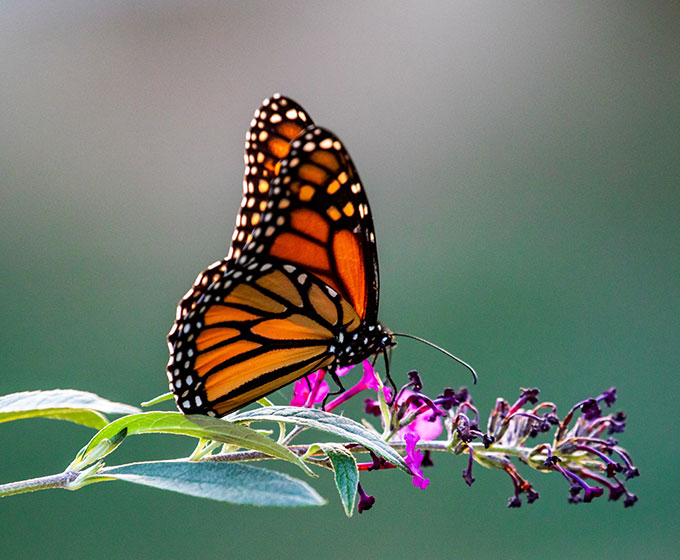
AUGUST 29, 2022 — Texas is a crucial stop along the migratory path of the monarch butterfly. The population travels from its summer habitat in the Northern United States and Canada south to Mexico for a warmer refuge during the winter season. Students and faculty in the UTSA College of Sciences (COS) are working to ensure that monarchs have the food they need on their long journey.
The monarch butterfly was recently declared endangered by the International Union for Conservation of Nature (IUCN).
Janis Bush, professor and chair of the COS’ Department of Integrative Biology, is leading a research team that surveyed the Texas landscape for milkweed which is critical to the survival of the monarch. The team has partnered with organizations such as U.S. Fish and Wildlife Services, the Monarch Joint Venture, and the National Butterfly Center.
“Monarchs are pollinators, and pollinators are critical for a healthy landscape and our food supply,” said Bush. “It’s been phenomenal working with people from different states and countries and to see how people come together for a common good. We’re working to ensure Texas is part of the solution and that Texas has a voice as the conservation community works to solve the problem and conserve monarchs. We all have an opportunity to be part of the solution.”
The team estimated the amount of milkweed and nectar plants across the landscape where monarch butterflies migrate. The monarchs make their trek across the state twice a year. They travel north in the spring and south in the winter. On their trip north, the population looks for milkweed to lay its eggs, and the adults need nectar plants for survival. The larva uses the milkweed as a food source for growth. As the monarchs return to the south during the winter months, they seek nectar plants to gain sugar necessary for their journey to Mexico.
“We’ve always focused so much on milkweed, which is vital. You have to have it. But I think it’s important for us to remember that the adults also need other nectar plants as they’re migrating through the state of Texas,” Bush said.
Bush and her team started their effort in 2015. Bush, Julian Chavez ’15, Hector Escobar ’15, Ursula Alvarado-Miller ’14 ’18, Monica Juarez ’17, and several undergraduate students surveyed plants along IH-35 and U.S. 281 from Alice, Texas to Wichita Falls, Texas, and from Pineland to Ozona, Texas. Over three years, they found and documented milkweed on the landscape.
“But one thing that was interesting and a bit concerning: There’s not a lot of milkweed if you move from San Antonio south to Laredo and Eagle Pass,” Bush said. “For the female monarchs to be able to lay their eggs, they really have to make it to either San Antonio or a little bit north of San Antonio.”
This long journey jeopardizes the survival of the population.
Bush explained that milkweed seeds germinate well, but the seedlings are hard to grow. The plants also die back—a process defining how aboveground portions of the plant die, but the roots are still viable.
More importantly, Bush says, patience is key.
“If people are impatient when they see the seedlings die back, they think the plant is dead and will pull it out of the ground. We found is that some of these species will die back and then resprout at the base of the next year or so,” Bush said.
Texas residents who want to support the monarch population should report sightings of monarchs on journeynorth.org
“It’s a great way for people to be involved,” Bush said.
UTSA Today is produced by University Communications and Marketing, the official news source of The University of Texas at San Antonio. Send your feedback to news@utsa.edu. Keep up-to-date on UTSA news by visiting UTSA Today. Connect with UTSA online at Facebook, Twitter, Youtube and Instagram.
Move In To COLFA is strongly recommended for new students in COLFA. It gives you the chance to learn about the Student Success Center, campus resources and meet new friends!
Academic Classroom: Lecture Hall (MH 2.01.10,) McKinney Humanities BldgWe invite you to join us for Birds Up! Downtown, an exciting welcome back event designed to connect students with the different departments at the Downtown Campus. Students will have the opportunity to learn about some of the departments on campus, gain access to different resources, and collect some giveaways!
Bill Miller PlazaCome and celebrate this year's homecoming at the Downtown Campus with food, games, giveaways, music, and more. We look forward to seeing your Roadrunner Spirit!
Bill Miller PlazaThe University of Texas at San Antonio is dedicated to the advancement of knowledge through research and discovery, teaching and learning, community engagement and public service. As an institution of access and excellence, UTSA embraces multicultural traditions and serves as a center for intellectual and creative resources as well as a catalyst for socioeconomic development and the commercialization of intellectual property - for Texas, the nation and the world.
To be a premier public research university, providing access to educational excellence and preparing citizen leaders for the global environment.
We encourage an environment of dialogue and discovery, where integrity, excellence, respect, collaboration and innovation are fostered.